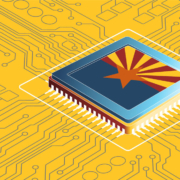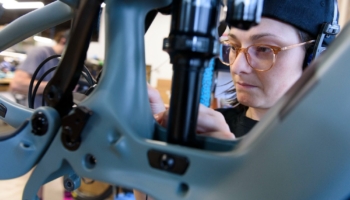At the Arizona Manufacturing Summit, a workforce plan comes into view that challenges conventional wisdom – and positions the state for success
Arizona manufacturing is having a moment. And like every state grabbing for a piece of America’s industrial comeback, leaders here are grappling with one challenge above all others: workforce.
Last week manufacturing and education leaders convened in Phoenix at the Arizona Manufacturing Summit to assess the current state of manufacturing employment and forecast the path ahead. Speakers at the event, co-presented by the Greater Phoenix Economic Council and Arizona Manufacturers Council, expressed high confidence that Arizona is poised to succeed where other states are struggling.
I helped moderate the discussion, that from industry included representatives from Intel, Taiwan Semiconductor Manufacturing Company (TSMC), VB Cosmetics, Heitek Automation, and Latham Industries. Educators from Arizona State University, Maricopa Community College System, Grand Canyon University, and Arizona’s K-12 ecosystem spoke to Arizona’s talent pipeline.
Arizona Commerce Authority Senior Vice President Allison Grigg helped establish an employment baseline, citing “more than 330,000 manufacturing jobs in Arizona across more than 5,400 companies.”
Standardized data from the Federal Reserve and U.S. Department of Labor, tied to NAICS industry codes and used across all states, pegs Arizona manufacturing direct employment at just over 192,000 jobs.
Regardless of the source, Arizona manufacturing employment has been on a tear: Economic Innovation Group’s (EIG) analysis of U.S. Department of Labor data estimates that just five states – Texas, Florida, Georgia, Utah, and Arizona – have accounted for over half of all U.S. manufacturing jobs added since 2019, including 16,797 jobs in Arizona alone.
The nuance of manufacturing employment is that sector jobs ebb and flow across different industries and Arizona is benefitting greatly from its industrial mix. On a national level, EIG estimates that “the transportation and food manufacturing industries have accounted for the lion’s share of job growth in the manufacturing sector post-pandemic; these were also the two leading industries for job growth within manufacturing after the Great Recession.”
In fact, Arizona’s legacy “transportation” companies have fueled the local boom: Honeywell Aerospace, Boeing, Northrup Grumman, and General Dynamics are top-10 manufacturing employers in Arizona (the feds’ NAICS designation includes aerospace in a broad NAICS Transportation classification).
All great, but the biggest reason for optimism here is Arizona’s burgeoning “computer & electronics manufacturing” (more NAICS) opportunity, i.e. semiconductor manufacturing. It’s also the source of the state’s biggest manufacturing employment challenge.
Consider first that more jobs have been lost in America’s computer and electronics manufacturing ecosystem than any other since 2000 – EIG estimates that “Despite the recent uptick…there remain 39 percent fewer jobs in computer & electronics manufacturing than in the year 2000.”
Arizona, Texas and other semiconductor outposts are in a position to reverse the trend. Grigg estimated that Arizona would add 18,000 or so manufacturing jobs by 2030. Many of these will be at Intel and TSMC and Amkor, and at hundreds of suppliers in the regional semiconductor supply chain.
There will be setbacks along the way. Intel’s Angela Creedon, speaking at the Summit, conveyed the challenge of announcing layoffs in Arizona at the same time the company is poised to receive a heavy dose of CHIPS-related subsidies – to undergird workforce development, in part. Intel has preliminarily qualified for $8.5 billion in grants under the CHIPS Act. The optics are, well, challenging.
Yet Intel is already Arizona’s top manufacturing employer – and given TSMC’s growth plans in the desert, more “computer & electronics manufacturing” jobs will add to an already dynamic manufacturing ecosystem. To wit, LinkedIn counts 10,783 current job openings at Arizona manufacturing companies.
Not all positions are production-focused, and educators at the Summit were hyperfocused on the evolving-skills mix. And for good reason. The make-up of the manufacturing workforce is changing. A study by Georgetown University’s Center on Education and the Workforce estimates that the percentage of manufacturing workers with bachelor’s degrees hit roughly 30 percent in 2016 compared with 8 percent in 1970. And a 2022 NAM (National Association of Manufacturing)-involved study found that nearly half of the manufacturing job openings that year, around 1.2 million, required at least a bachelor’s degree.
I quipped to Binil Starly, School Director at ASU’s School of Manufacturing Systems & Networking and Summit speaker, that a decade ago, ASU wouldn’t have bothered to attend. Starly smiled like the cat that ate the canary. Today, ASU is leaning into manufacturing with a $200 million investment in its southeast Mesa Polytechnic campus in the form of a 100,000 sq. ft. advanced manufacturing center. Intel hires more ASU grads than from any .edu outpost. Grand Canyon University’s new Dean of the College of Engineering and Technology, Paul Lambert, spoke passionately at the Summit about GCU’s investment in manufacturing. He’s a qualified source – an ex-Air Force pilot and retired Boeing executive. Things have changed. And if other states have been slow to benefit from university involvement – and planning – that’s not the case here.
But if university grads are key to manufacturing’s future, today, companies here and elsewhere continue to rely on human capital from the trade and vocational pipeline. In Arizona, the primary talent engine is the Maricopa County Community College system (MCC). Speaking at the Summit, Daniel Barajas, chief officer of Workforce & Economic Development Strategy for MCC, described a system working overtime to fill Arizona’s growing demand for talent – via a network of colleges and programs that today is highly integrated with industry – not only semico’s, where CHIPS-funded development programs will in part unfold through MCC – but Arizona’s stable of established manufacturers.
Here then, is the rub. Today, manufacturers like Latham Industries and VB Cosmetics and Heitek Automation (represented at the Summit by Tracy Latham, Bob Acheson, and Dan Heitek) and a hundred others, are competing with Intel and TSMC for the same talent. The technicians, operators, welders, and dozens of other trade grads that Barajas’ MCC (and Tucson’s Pima Community College system) are churning out continue to be the workforce lifeline for Arizona manufacturing, as important the university system is becoming. All educators here have a secure place in Arizona’s future manufacturing economy; the journey there will be messy, and competitive.
But this orchestra of talent all seems to be headed in the same direction here, where in other states, not so much. Arizona’s tight geography also helps; Phoenix and Tucson are competitive but fuel nearly adjacent manufacturing ecosystems. Other synergies are developing organically: Phoenix’s West Valley is becoming a transportation and logistics hub for the entire state. Chandler and Mesa and points in SE Phoenix are expanding in the manufacturing game.
NAM forecasts nearly 4 million new U.S. manufacturing jobs in the coming decade. Arizona’s ambition is to compete for a growing share. If workforce is a differentiator – and it is today – AZ will be a key cog in America’s neo-industrial future.
Bart Taylor is a Moss Adams BDE and founder and former publisher of the AZ MFG REPORT. Reach him @ bart.taylor@mossadams.com
Arizona Manufacturing Summit | October 23, 2024 | Phoenix, Arizona
Speakers/Panelists
Economic Development
- Allison Grigg, Senior Vice President, Arizona Commerce Authority
Industry
- Angela Creedon, Arizona Public Affairs Manager, Intel
- Pearl Chang Esau, Founder, Shan Strategies
- Dan Heiling, CEO, Heitek Automation
- Robert Acheson, CEO, VB Cosmetics
- Tracy Latham, CEO, Latham Industries
Education
- Binil Starly, School of Manufacturing Systems & Networking, Arizona State University
- Paul Lambert, Dean, College of Engineering and Technology, Grand Canyon University
- Tracy Rexroat, CTE Curriculum Connection, National CTE Advisory Council
- Daniel Barajas, Chief Officer of Workforce & Economic Development Strategy, Maricopa Community Colleges
Presented by:
- Greater Phoenix Economic Council
- Arizona Chamber of Commerce & Industry
- Arizona Manufacturers Council
- AZ MEP
Sponsored by:
- JPM CHASE
- Moss Adams
- Lockton
- Keyser



